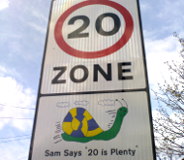7/8/2014
UK: Injuries And Accident Rise In 20 MPH ZonesAccidents and injuries rise in new 20 MPH zones in England.

Lowering urban speed limits to 20 MPH has been all the rage in the UK. This month, the city of London officially adopted the 20 MPH limit for all boundary roads, with the exception of Westminster. While this is being done in the name of improving safety, the latest statistics suggest accidents are actually on the rise in the lower speed limit zones.
The Institute of Advanced Motorists (IAM) on Friday cited government accident statistics to show serious accidents increased 26 percent in 20 MPH zones last year. Less serious accidents increased 17 percent. Serious injuries rose 29 percent and less serious injuries increased by 19 percent. On the higher 30 MPH and 40 MPH roads, serious accidents dropped 8 percent.
"More and more roads are being given a 20 MPH limit but they do not seem to be delivering fewer casualties," IAM chief executive Simon Best said in a statement. "The IAM are concerned that this is because simply putting a sign on a road that still looks like a 30 MPH zone does not change driver behavior."
The dismal results are nothing new. The late Paul Smith, founder of the Safe Speed road safety campaign, fought against the 20 MPH speed limits in 2007, citing official statistics that showed the likelihood of accidents increased in the 20 MPH zones. The lowered limit zones kept expanding, nonetheless.
"The authorities continue to treat road safety as a problem of vehicle physics when in fact it is a complex problem of human psychology," Smith said at the time. "There's no indication that any of the 'speed kills' policies have made our roads safer. Speed cameras, traffic calming, speed limit reductions and so on have all been rolled out across the country with no significant reduction in road deaths or road crash hospitalizations."
Smith argued that encouraging drivers to constantly watch their speedometers out of a fear of receiving a ticket distracted motorists. Looking down causes drivers to take their eyes off the road, making it more likely that they would miss a potential hazard, increasing the chance of a collision.
Special interest groups that profit from the issuance of traffic tickets, such as insurance companies, have broadly backed the lowering of speed limits.


